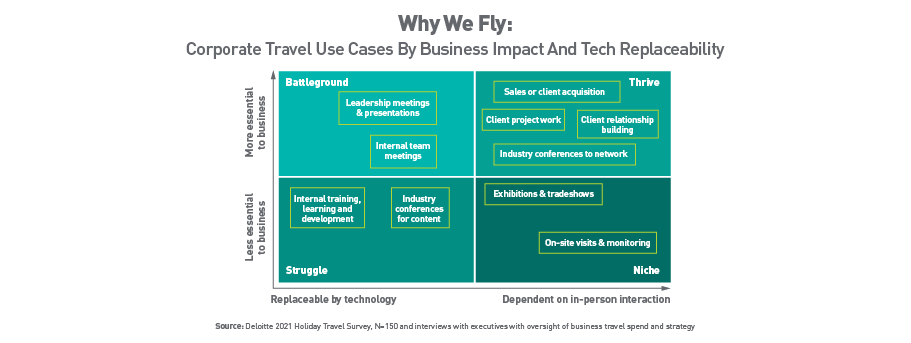
B2B Digital Marketing Strategy: 3 Critical Industry Changes You Need to Know
During the two years of the pandemic, we were forced to stay home and not travel. Business was anything but “business as usual.” Overnight, The B2B world had to grow new synapses to reach, educate, and sell to new and existing clients remotely. While phone and Zoom calls picked up much of the slack for B2B marketers, digital marketing was also forced to evolve significantly.
In today’s edition of Plain Talk, we’ll outline the three biggest industry changes that will “stick,” how they affect your B2B digital marketing strategy, and what you need to do about them.
- Business Travel as an Indicator
- Has Decreased Business Travel Led to Increased Digital Marketing?
- 3 Takeaways for B2B Digital Marketing Strategy
- Get Expert Help With Your B2B Digital Marketing Strategy
Business Travel as an Indicator
In April 2022, 85% of businesses were traveling again—up significantly from just 65% in January. For many, the pandemic proved that much travel was unnecessary, so it’s unlikely business travel will completely recover to pre-pandemic levels soon. Things that companies state are still holding back business travel are:
- Many businesses are still in work-from-home mode, or at least aren’t back in a significant way just yet. Some never plan to return to offices. This makes visiting customers more difficult.
- Many businesses that are back in the office are still not receptive to face-to-face visitors in the same way they were in 2019 (although this is diminishing quickly.)
- Businesses find many meetings are better accomplished online. When you don’t have to travel, you can be more productive with the time you’re not spending in hotels and airports.
- CFOs and CEOs are more reluctant to approve travel, knowing that businesses have adapted without travel for the past two years.
- An increased emphasis on the environmental impacts of travel and corporate ESG scores have placed more scrutiny on business travel.
So while vacation travel has come back with a vengeance, the American Hotel & Lodging Association and Kalibri Labs announced in mid-April that they expect 2022 business travel revenues to be down 23% nationwide from 2019 numbers and for revenues not to recover to 2019 levels until at least 2024.

Has Decreased Business Travel Led to Increased Digital Marketing?
Yes, but before we go further, we need to agree on a definition of what is digital marketing? For the purpose of this article, we will be adopting a broad definition; “Digital marketing, also called online marketing, is the promotion of brands to connect with potential customers using the internet and other forms of digital communication. This includes not only email, social media, and web-based advertising, but also text and multimedia messages as a marketing channel.”
Using this broad definition, a recent Chief Marketing Officers (CMOs) survey found that across owned, paid, and earned media, a whopping 72.2% of spending was intended to be exclusively digital in 2022. This doesn’t even account for partner or event budgets that might be executed using digital tactics.

Further, looking at just paid media budgets from July 2021 eMarketer research, while overall B2B ad spends dipped in 2020, a significant proportion of budgets was moved to digital, causing digital advertising spending to rise more than 32% in 2020 then another 25% in 2021. It is expected to rise 16.8% and 15.1% respectively in 2022 and 2023.

But it’s not just paid media. According to the Content Marketing Institute’s 12th Annual Content Marketing Survey, 66% of B2B marketers went into 2022 with a plan to increase their content development budgets. Marketers report the best results coming from webinars, research articles and white papers.
3 Takeaways for B2B Digital Marketing Strategy
1. Coordinate and customize sales, marketing, and customer service via a demand center.
According to an August 2021 Harvard Business Review article:
“Demand centers identify business opportunities through inbound marketing (e.g., personalized customer journeys with tailored content and experiences) and outbound marketing (e.g., paid media, events, webinars, and emails to find customers). Demand centers prioritize and qualify leads and orchestrate customer outreach. Sometimes, the response is digital (e.g., the demand center generates an email with personalized content). Other times, the demand center provides guidance and content to help an inside or field salesperson follow up. Together, digital tools and humans adapt to connect with customers at the right moment in their buying cycle.”
“B2B Customers Expect More Than Ever. Demand Centers Can Help.” Harvard Business Review
With the increased demand for content and higher scrutiny of travel impact on budget, time and the environment, smart marketers are using technology to better understand their customers as individuals, track their progress through the sales cycle and deliver custom content in near perfect coordination with their sales team’s efforts. These efforts are managed through modern customer relationship management (CRM) systems that monitor all touchpoints and utilize automated workflows to deliver timely, personalized content. So, it’s not just enough to develop more content; you also must integrate it intelligently into your funnels.
2. Storytelling may be as old as fire, but it has never been more important than it is now!
Way back in 2019, charismatic road warriors made frequent trips to important B2B customers armed with technical literature and data points, and they told the company’s story over steaks grilled in butter and glasses of cabernet. That happens a lot less now. While it’s always been important, storytelling in B2B marketing now is critical, as our websites, articles, ads, videos, and emails must help communicate this important cultural ritualism. In our previous article, Why Storytelling Matters in B2B Marketing, we address how building a strong narrative for your product or service can make your content up to 22 times as memorable. So, organizing your facts and content around a great story elevates your brand as unique regardless of your category.
Further, it makes your benefits memorable and, for lack of a better word, maybe even fun, so take the time. Make the effort. Make it interesting. In today’s world, we hear our attention spans are shorter than that of goldfish. Remember, however, that most of us (including your customers) can binge-watch a Netflix series over a weekend. We don’t have short attention spans, and we have no patience for boring content. Now that we’re breaking bread less with our customers, storytelling is even more important!
3. Prepare now for a world without third party cookies.
There’s an excellent chance that you have read a half dozen articles about this. We wrote about it in January 2021, and it was one of our most-read articles. If you’re not there yet, don’t worry; you’re not alone. So, specifically, what should you be doing knowing many smaller browsers have already disabled third-party cookies and that Google will do the same with the Chrome browser (64.3% market share) by the end of 2023? Here’s a checklist:
a. Collect and organize zero-party data.
This is data that customers volunteer to you. This could be through warranty forms or social media questions. Collect it, organize it, integrate it, and use it.
b. Only third-party cookies are going away. Utilize and maximize your first-party cookies.
Anything your customers do on your site is fair game. Review how you collect this data and even structure your site to test and measure your site users’ buy-intent. You have to make more of less.
c. Familiarize yourself with Privacy SandBox®.
Privacy SandBox is Google’s open-source initiative to personalize web experiences without third-party cookies. To quote an April 2022 Cognism article, “Google’s Privacy Sandbox uses technology that targets individuals based on larger groups of people that act similarly, have expressed similar interests, or frequently visit similar websites, called Google Topics.”
d. Shift more resources to search engine optimization (SEO) and pay-per-click (PPC).
Thus, you’ll rely more on earned and variable paid pull in the absence of third-party data to direct push.
e. Implement Google Analytics 4 (GA4).
While it’s been available since October 14, 2020, most marketers are still running Universal, or GA3, which was launched in 2013 for data continuity. We’d recommend you run them both. GA3 goes away on July 1, 2023. GA3 and GA4 track differently. Historic GA3 data will not be available in GA4. Implementing GA4 now will give you a year of data before GA3 goes away.
f. If you’re not using Google Looker Studio or similar software for reports, plan to within the next year.
While GA3 data won’t be accessible in GA4, both can be integrated and blended in Google Data Studio, thus protecting the historic integrity of your analytics.
Get Expert Help With Your B2B Digital Marketing Strategy
So, while many of us feel like we’ve aged five years in the last two, it’s clear that digital B2B marketing has advanced at this more rapid rate. As marketers, it’s important that we grow and evolve to stay at pace and sometimes even get ahead.
If you have any questions about marketing to other businesses, call us at 502-499-4209 or contact us online. We’re happy to help!
Our Articles Delivered
Signup to receive our latest articles right in your inbox.







